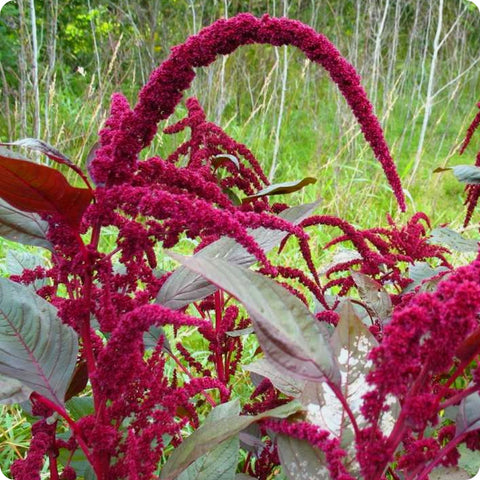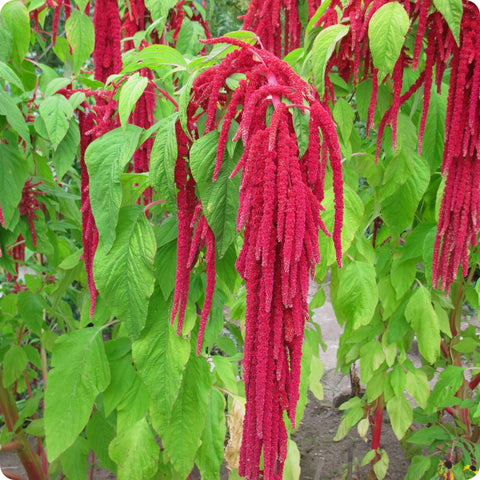In case you’re looking for amaranth flowers. Let me first inform you that it’s a lovely flower that comes in a variety of hues.
Due of its significance in Greek mythology for healing, amaranth is a rare flowering plant with a hanging appearance. In the Bible, amaranth is described as being pure, and Jesus Christ utilized it as a dietary grain. Since amaranth does not fade after wilting, the word’s meaning of “everlasting” is undoubtedly accurate. It is grown for food and has advantages like complete protein with the right amino acids.
Table of Contents
Amaranth Flower Meaning
Immortality, love, affection, fondness, and charm are the meanings and symbols associated with amaranth flowers. It is difficult to understand the exact significance of this flower, but because perennial flowering plants also have everlasting blossoms, many people think it also symbolizes such. As a present, it can communicate to the recipient your kind deed, friendship, concern, and inner beauty.
It is used during weddings as a way for the couple to express their commitment to one another and the idea that their love will endure forever. The plant’s positive trait is that it continues to flower and never fades, just as people have imagined it to be an endless, lovely bloom. The herb has long been believed to have healing properties, and after several years of research on animals, it has been found to help with issues like diarrhea, high cholesterol, edema, and ulcers. According to Webmd, it includes antioxidants that reduce inflammation, however there is no evidence that it can be effective in humans.
Amaranth flower symbolism
The amaranth blossom is a representation of grace, immortality, endless life, or enduring love. Almost any garden can accommodate amaranth. They are attractive plants that grow both annually and perennially. The meanings associated with this plant are varied. A symbol of eternal life, beauty, and immortality because of its never-fading blossom is the amaranth flower.
Although only tested on animals, it is a food crop and may be able to treat a few ailments. Amaranthus can be grown indoors with some mild shade, although it prefers full sunlight. For this flower, a good organic potting soil with a compost basis is ideal.
The amaranth flower enjoys warm environments and can be cultivated from seeds, which require moisture in the first few days of growth. I’ve grown it all the way up, so watering is crucial for the germination phase. Avoid growing them during winter frost because it can easily destroy the seed.
In several civilizations, the amaranth flower is used to represent rebirth, purity, immortality, and renewal. The flower’s durability and strength make it a biblical symbol for the virgin Mary, whose name also implies strength, purity, and beauty.
Amaranth flower colors
Among the colors of amaranth flowers are red, green, blue, pink, purple, and orange. The amaranth plant’s most typical blossom color is reddish; it grows as an annual and can beautify your garden bed. It can also be grown in containers. The golden giant has yellowish blooms, but the Fat-Spike variant has purplish to red hues. They are low-maintenance plants that often bloom in the summer or fall. The plant reaches a height of two to three feet and a width of three feet.
Amaranth flower language
The meaning of the amaranth flower in the language is an unwavering, unchanging passion or affection for people. The name “amaranth flower” comes from the Greek word “amaranths,” which represents eternal immortality. It also connotes money, ambition, royalty, and beauty. Additionally, they are gifts intended to bring fortune and happiness to the recipient.
Amaranth flower tea
Globe amaranth tea is essentially a miracle beverage with heart-healthy magnesium properties. It also contains vitamins and minerals that can help with a variety of issues, such as skin, collagen, muscle exhaustion, and blood pressure reduction. Additionally, because it also contains vitamin C, it aids in the processing of iron. The lysine amino acid found in amaranth leaves aids in calcium absorption. They are a good source of protein, fiber, and phosphorus, all of which the body needs to produce energy. Some people refer to this herbal tea as a superfood, while others believe that it can treat a variety of ailments since it contains several vitamins, including vitamin K, folate, vitamin A, and others.
Amaranth flower seeds
Amaranth flower tattoos
The tattoo of an amaranth blossom represents immortality and everlasting life. Due to the fact that it never expires even after wilting, the amaranth blossom has cultural significance. The meaning behind this tattoo relates to the flower’s propensity to thrive in many climatic situations. Additionally, the plant is linked to power, goodness, nourishment, endurance, passion, beauty, and healing.
Although the majority of amaranth tattoos vary depending on the culture, the fact that they never fade makes them stronger and more uplifting. These flowers teach us about the world, nature, and how everyone lives in harmony with one another.
Amaranth flower edible
Especially a crimson amaranth flower, whose edible stalks, seeds, blooms, and stems make it a good food source. They are teeming with protein and other nutrients that can strengthen bones and provide your body with antioxidants to defend itself from the inside. A rare kind of red amaranth flower is used as a superfood. However, the original purpose of amaranth was to treat numerous ailments.
Amaranth flower benefits
Amaranth flower seeds, which are edible and high in protein, have medical benefits. This crop, which has more protein than other edible crops like rice and rye by more than 30%, provides the amino acid lysine.
These plants are adaptable to various climatic situations. They offer benefits that can lower cholesterol levels in the body and are everlasting blooms, however the research on these flower seeds is incomplete and the study is small.
They do make wonderful houseplant, and they were once used as a food crop.
Is amaranth flower poisonous?
Yes, oxalates in amaranth (also known as pig weed) and other unknown chemicals can be dangerous. Insoluble calcium oxalates are created when soluble oxalates combine with the calcium in blood. The kidney then filters them, but this causes issues like oxalate nephrosis. When the number of oxalates is increased yet there aren’t enough enzymes to break them down, it leads to this condition and may also result in renal failure.
What is the Cultural Significance of an Amaranth Flower?
Panquetzaliztli, commonly known as the Aztec (Mexican calendar) month, is when people perform rituals, adorn their homes, and celebrate the month by dancing. The people in the Aztec festival fast or eat very little, just as is customary in many religions.
Amaranth seeds are used to build a statue of the god, hence it is quite significant from a cultural perspective. People appreciate the cuisine as it is produced from seeds and honey after the festive month.
Aztecs are from a variety of ethnic backgrounds, and their culture is unique to central Mexico. The amaranth flower, also known as love lies bleeding, is thought to represent immortality because its flowers never wither or fall off.
Greek mythology also had a connection to amaranth blossoms, albeit no one was aware of them at the time.
Sources
https://s3.wp.wsu.edu/uploads/sites/2073/2014/03/091412.pdf
https://csuvth.colostate.edu/poisonous plants/Plants/Details/81
https://en.wikipedia.org/wiki/Amarant
https://en.wikipedia.org/wiki/Aztecs
https://www.extension.iastate.edu/alternativeag/cropproduction/amaranth.html
http://heritagegarden.uic.edu/amaranth-amaranthus



